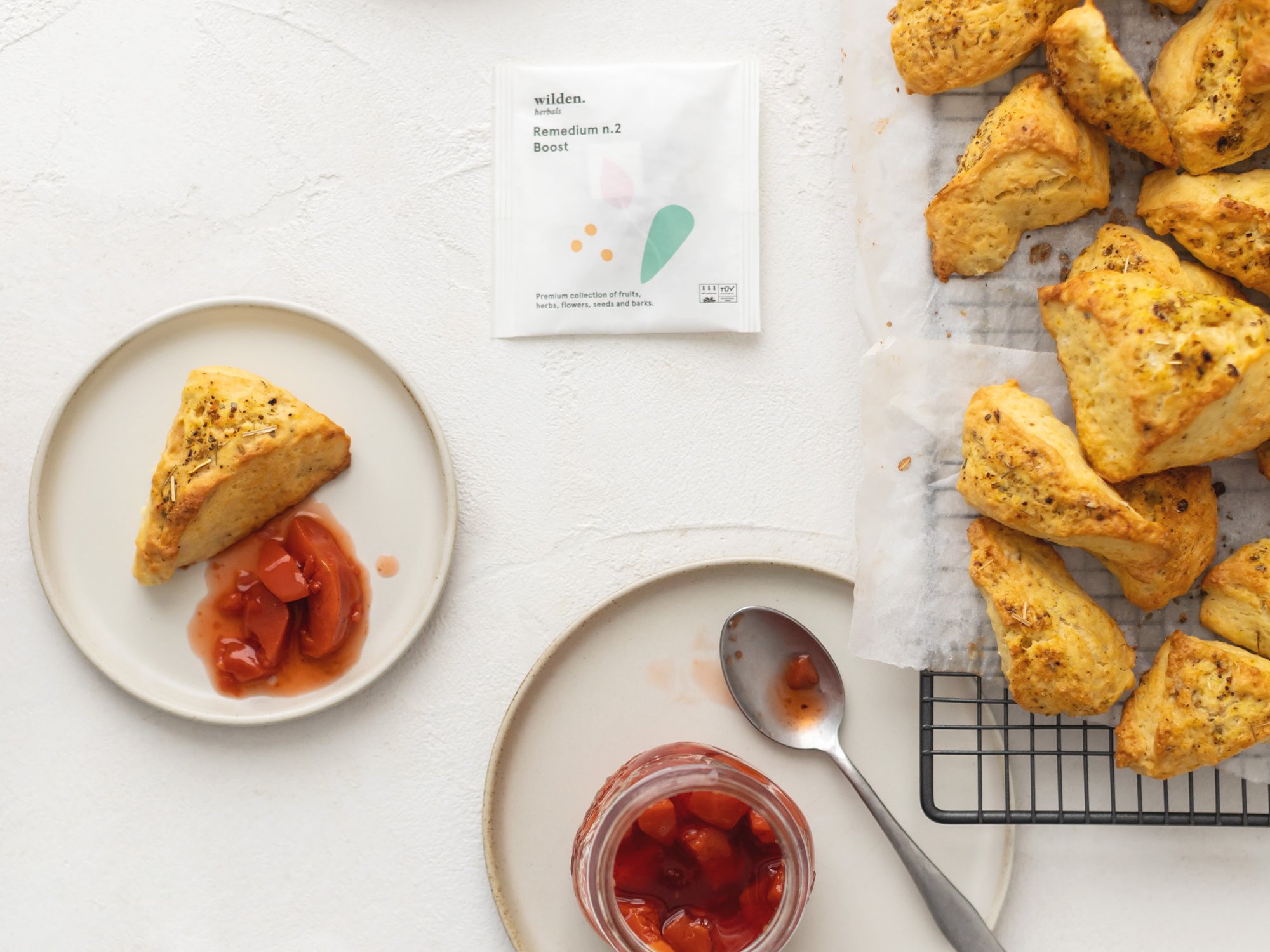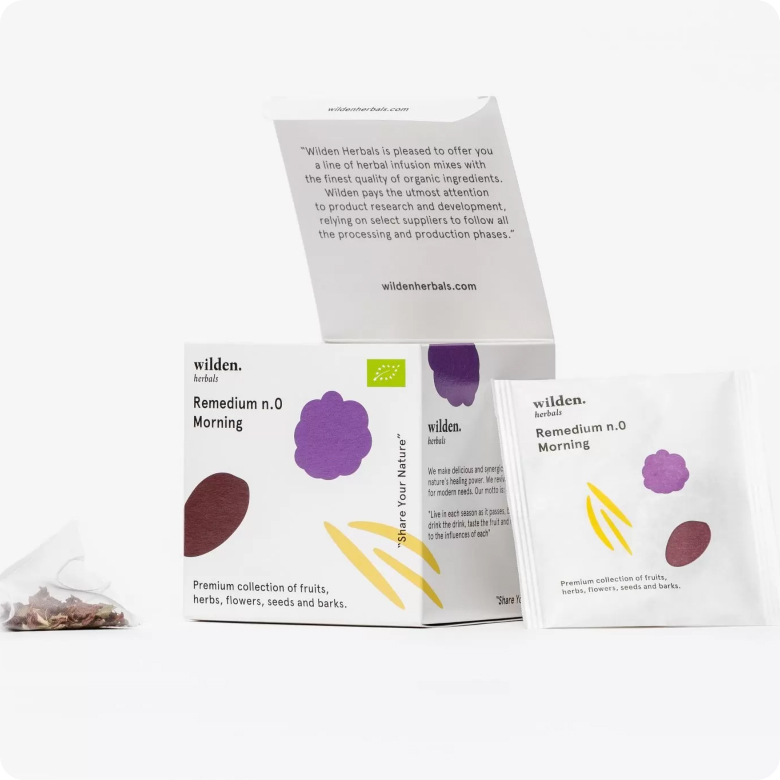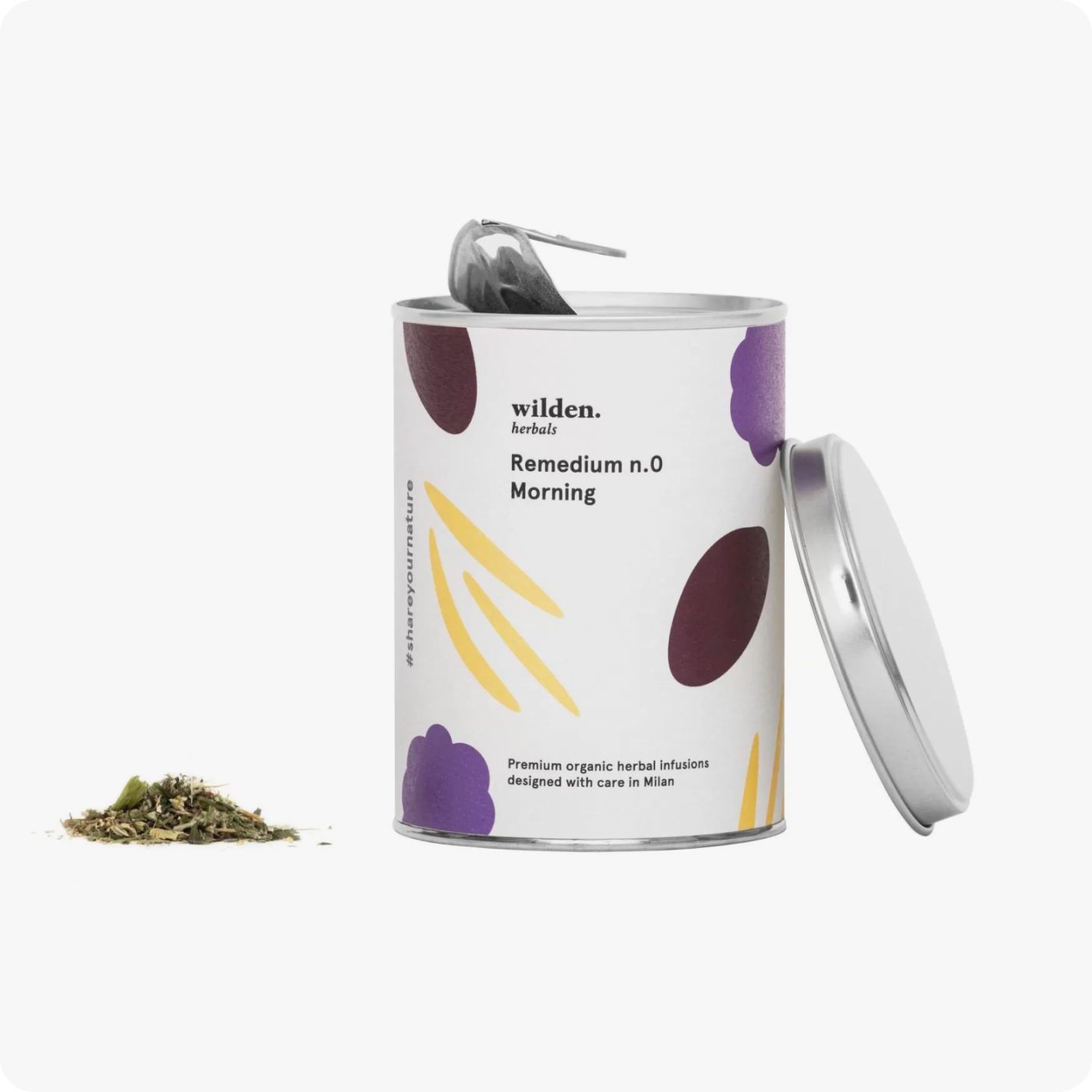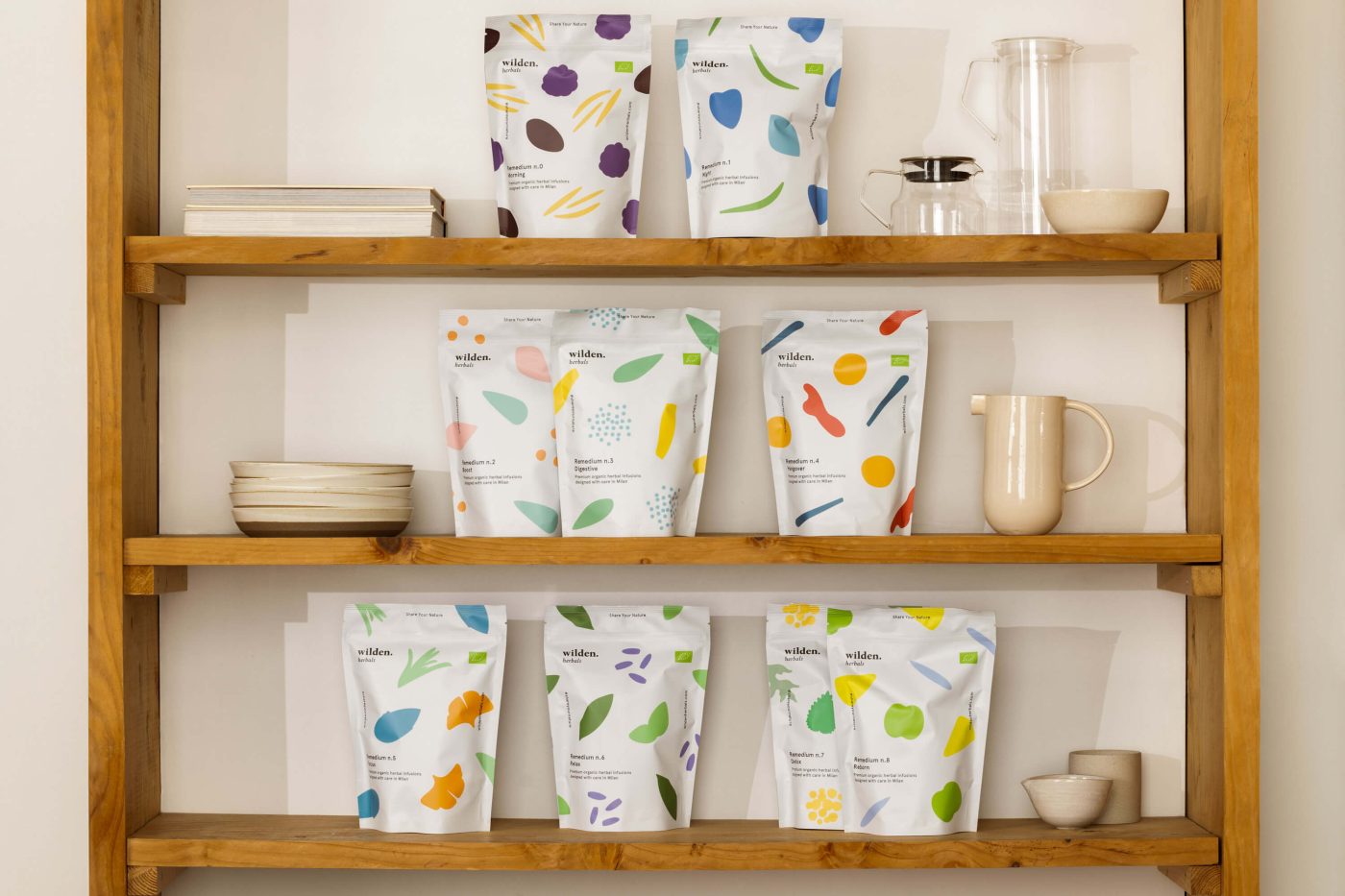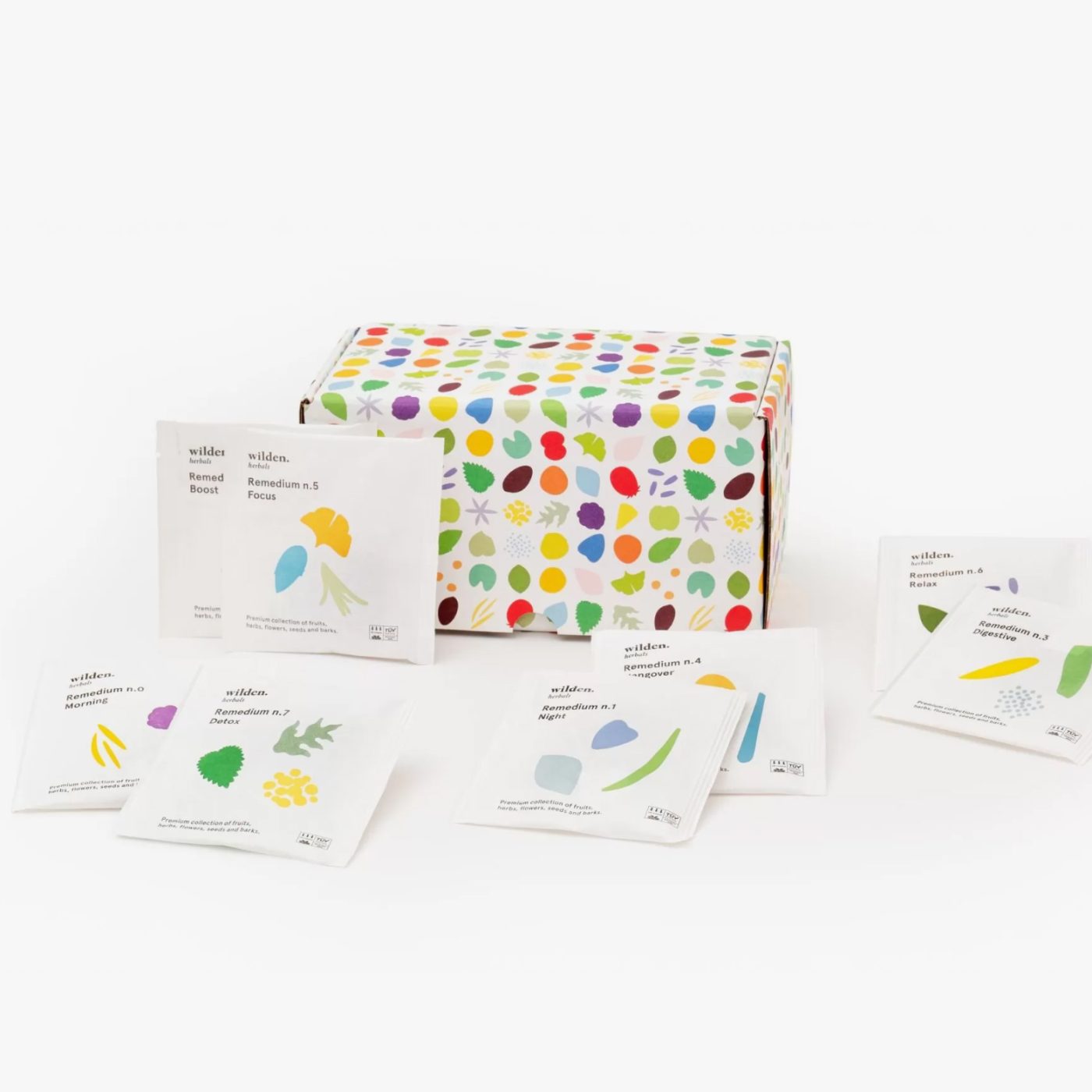Remedium No. 5 – Focus
From composition to benefits, Wilden.herbals chronicles its herbal teas one by one on a journey to discover the power of plants.
Remedium No. 5 – Focus is an herbal tea made for thinking, for having a clear head in order to be able to reframe and deepen. In fact, the balance of this herbal tea rests on flavors and aromas capable of restoring harmony with oneself during break times or before beginning a meditation practice. Focus aims to be an all-day companion for those who love sweet, aromatic notes of mint and basil, but also seek sweetness in the fresh taste of citrus fruits such as verbena and melissa moldavica. The papilliferous journey continues in flavors reminiscent of the Mediterranean, thanks to rosemary and the delicate scent of pink rhodiola. All accompanied by a good, slightly astringent body developed on maté, ginkgo and Asian centella.

Verbena, Verbena Officinalis
Centella asiatica, Centella asiatica
Ginkgo Biloba, Ginkgo Biloba
Maté, Ilex Paraguariensis
Mint, Peppermint
Melissa Moldavica, Dracocephalum Moldavica
Basil, Ocimum Basilicum
RhodiolaRosa, Rhodiola Rosea
Rosemary, Rosmarinus Officinalis
Mint, Peppermint
Peppermint, a variety of the genus Mentha, is a plant of European origin now cultivated and appreciated worldwide; rich in enzymes and flavonoids, it owes most of its beneficial properties to menthol. Mint, already appreciated in ancient times by the Egyptians and Greeks, promotes respiration, invigorates the nervous system, aids digestion, protects the liver and intestines, and alleviates symptoms of flu, colds and diarrhea. The infused leaves release all the aromas and essences with their characteristic flavor, which promotes proper digestion, releasing a pleasant sensation of freshness.

Rosemary, Rosmarinus Officinalis
Rosemary is a classic plant of Mediterranean culture that has been valued for centuries for its balsamic and medicinal properties; in medieval culture it is attributed magical properties, making it suitable for a variety of uses and applications. Rosemary, rich in sodium, flavonoids and essential oils, has beneficial properties mainly for the digestive and circulatory systems. In infusion it aids digestion, has astringent power, and promotes liver function.
Ginkgo, Ginkgo Biloba
Ginkgo biloba L. is a prehistoric plant (250 million years old) that has always been prized for its therapeutic and beneficial properties; its dietary and therapeutic uses flourish with the tradition of Chinese medicine and with the dawn of “Western” phytotherapy. Infused leaves release low concentrations of gingkolides, natural tonifiers and antioxidants with a veiled digestive action. Ginkolide B is perhaps the main player: it acts strongly on microcirculation and has a strong antioxidant action.

Verbena, Verbena Officinalis
Verbena (Verbena Officinalis L.) is native to Europe, and quite widespread in our country up to 1400 m (4,000 ft). Also called columbine her b or crocus herb, it has historically been widely used for its beneficial properties throughout the peninsula, as far back as ancient Roman times, where it was considered sacred; by extension, all sacred plants such as laurel,olive and myrtle were themselves called verbena. The main use of verbena (flowers and leaves) sees it featured in infusions and herbal preparations with draining, analgesic, antipyretic, calming and diuretic properties. The flowering tops are used in decoctions to defeat throat inflammation by gargling.
Centella asiatica, Centella asiatica
Centella asiatica (or Hydrocotyle asiatica) is aherb belonging to the Apiaceae family widely used in traditional Chinese medicine and Ayurveda.Centella asiatica is attributed with anti-inflammatory and hypotensive properties. Its oral intake is suggested to improve memory and cognitive abilities and in cases of fatigue, anxiety, as well as to treat trauma, wounds and circulation problems. Finally, centella asiatica is indicated for sunstroke, tonsillitis, pleurisy, hepatitis, stomach pain, indigestion, as well as asthma, anemia and diabetes. Applied to the skin, centella asiatica, on the other hand, finds application in the treatment of wounds and scars, including stretch marks associated with pregnancy.
Maté, Ilex Paraguariensis
Maté or yerba mate is an infusion made from the leaves of Ilex paraguariensis A. St. Hill. Considered a national drink in Argentina and Brazil, drinking maté is almost a ritual, like coffee for Europeans. In fact, the drink is considered a natural source of caffeine. Maté extracts are able to activate the so-called TGR5 receptor, a receptor involved in the regulation of basal metabolism and energy expenditure, which is also beneficial for the immune system. To produce maté, the terminal parts of the twigs are cut off and exposed to heat to inactivate the enzymes; in this way it is possible to maintain the characteristic green color of the leaves, which are then dried and broken up, ready then to prepare infusions.
Melissa Moldavica, Dracocephalum Moldavica
Lemon balm moldavica is a plant native to the southern regions of Siberia and the Himalayan area, now naturalized in Central and Eastern Europe as well. It is well adapted to the cold climate and arid and/or valley floor soils of both alpine and sub-alpine areas. Usually 60 cm tall, melissa moldavica can reach up to 1.5 meters in height. With characteristic dark green leaves , lemon balm has lilac-colored flowers that have an approximately 10-cm calyx, typically tubular bilabiate. Dried flowers and leaves are used as flavoring agents in foods and beverages; just by rubbing a moldavica lemon balm leaf, it will eventually be possible to perceive the intense citrus fragrance, given by its high citral content.

Basil, Ocimum Basilicum
Native to tropical Asia, basil is a plant that-through the Middle East-went to Europe, especially to Italy and southern France; from there it then spread throughout Europe. Many properties are associated with a plant that is unfailing on Mediterranean tables: with analgesic, bechic, diuretic, as well as sedative and – not least – aphrodisiac properties, basil is a miraculous plant. Useful in cases of insomnia, as well as asthma, bronchitis and coughs, colds, flu and headaches, it can increase breast milk production during lactation and soothe the discomfort of insect bites.
Rhodiola Rosa, Rhodiola Rosea
Native to Northern Europe and North Asia, rose rhodiola was anciently used in Russian folk medicine, as well as in Scandinavian countries, as it was considered very useful in treating cold symptoms. However, its uses date back to much earlier times. In fact, historical sources mention pink rhodiola as early as the Vikings, who used it as a restorative remedy after prolonged physical exertion because of its invigorating tonic properties. Among its recommended applications, rhodiola is also useful in the treatment of headaches and fatigue. In the “Materia Medica” by botanist Linnaeus, infused rhodiola is described as an excellent astringent, useful for relieving oral cavity pain. The root, on the other hand, would be a panacea for treating skin affections.
Sources:
- Wagner, H., & Ulrich-Merzenich, G. (2013). Evidence and rational based research on Chinese drugs. Wien: Springer.
- Phytotherapy, rational use of plant drugs, F. Capasso G. Grandolini A.A. Izzo Springer
- Bates SH, Jones RB, Bailey CJ, Insulin-like effect of pinitol, British Journal of Pharmacology 2000; 130(8): 1944-1948
- Kamara BI, et al, Polyphenols from honeybush tea, Journal Agricultural Food Chemistry 2003; 51(13): 3874-3879
- Kenneth M. Klemow, Andrew Bartlow and Justin Crawford, Herbal Medicine: Biomolecular and Clinical Aspects.
- Barnes Joan, Anderson A. Linda, Phillipson David J. Herbal Medicines, Pharmaceutical Press 2007.
- Blumenthal M., Goldberg A., Brinckmann J (Ed). Expanded Commission E Monographs, American Botanical Council and Integrative Medicine Communications 2000.
- European Scientific Cooperative on Phytotherapy (Ed). Melissea folium, ESCOP Monographs on the Medicinal Uses of Plants Drugs, Centre for Complementary Health Studies, Université d’Exeter 1996.
- Franchomme P. et Pénoël D. L’aromathérapie exactement. Encyclopédie de l’utilisation thérapeutique des huiles essentielles. (Aromatherapy exactly. Eencyclopedia of the therapeutic use of essential oils).
- Roger Jollois Éditeur 1990 Pizzorno JE Jr, Murray Michael T (Ed). Textbook of Natural Medicine, Churchill Livingstone 2006
- Organisation mondiale de la santé (World Health Organization). WHO monographs on selected medicinal plants, vol. 2, Suisse, 2002.

